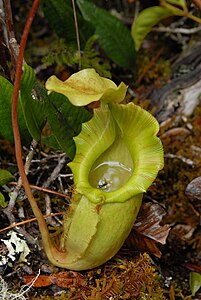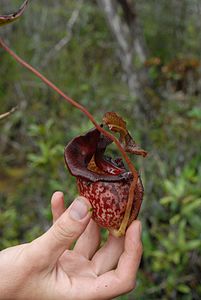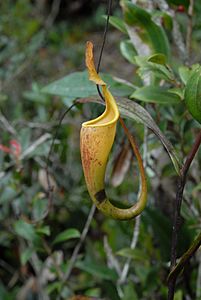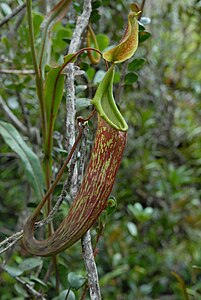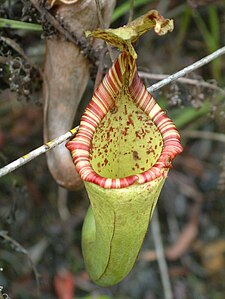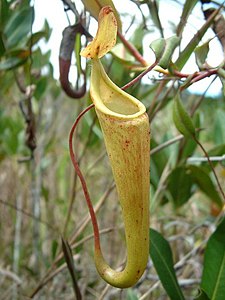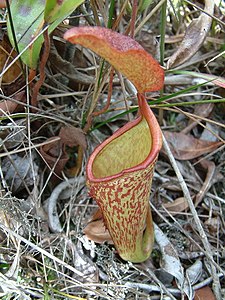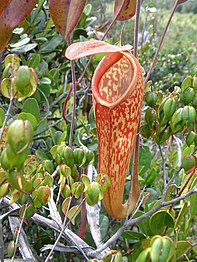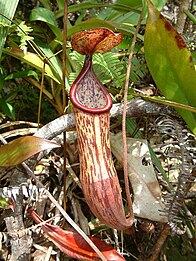| Nepenthes maxima | |
|---|---|

| |
| An upper pitcher of Nepenthes maxima from Sulawesi (~400 m asl) | |
| Conservation status | |
 Least Concern (IUCN 3.1) | |
| Scientific classification | |
| Kingdom: | Plantae |
| Clade: | Tracheophytes |
| Clade: | Angiosperms |
| Clade: | Eudicots |
| Order: | Caryophyllales |
| Family: | Nepenthaceae |
| Genus: | Nepenthes |
| Species: | N. maxima |
| Binomial name | |
| Nepenthes maxima Reinw. ex Nees (1824) | |
| Synonyms | |
Synonyms
| |




Nepenthes maxima (/nɪˈpɛnθiːz ˈmæksɪmə/; from Latin: maximus "greatest"), the great pitcher-plant, is a carnivorous pitcher plant species of the genus Nepenthes. It has a relatively wide distribution covering New Guinea, Sulawesi, and the Maluku Islands. It may also be present on Wowoni Island.
Nepenthes maxima belongs to the loosely defined "N. maxima complex", which also includes, among other species, N. boschiana, N. chaniana, N. epiphytica, N. eymae, N. faizaliana, N. fusca, N. klossii, N. platychila, N. stenophylla, and N. vogelii.
Variability
This species exhibits great variability across its range, particularly in the plasticity of its pitchers. Plants growing in drier, somewhat seasonal parts of New Guinea generally produce elongated pitchers with narrow peristomes and well-developed waxy zones, while those inhabiting perhumid areas often have a reduced waxy zone and enlarged peristome. This is thought to be because the peristome, when fully wetted, is more effective at trapping prey than the waxy zone, but performs poorly in drier conditions.
| Lower and upper pitchers of various forms of N. maxima from around the Anggi Lakes, West Papua, New Guinea |
Certain forms of N. maxima produce distinctly wavy laminar margins, a trait particularly common in plants from Sulawesi. In extreme examples, even the decurrent wings of the leaf—which can extend down the entire length of the stem's internode—may be highly undulate. Such rippled patterns result from increased cell growth near the edges of the leaf, which causes its thin, planar surface to buckle as it assumes the conformation with the lowest energy state.
| Nepenthes maxima exhibits extraordinary variability across its range, as evident in this selection of upper pitchers produced by plants from (left to right, top to bottom) Sulawesi at 400 m, Sulawesi at 700 m, New Guinea at 1500 m, New Guinea at 1600 m, New Guinea at 1700 m (two pitchers), New Guinea at 2300 m, and New Guinea at 2600 m. |
Infraspecific taxa
- Nepenthes maxima f. undulata Sh.Kurata, Atsumi & Y.Komatsu (1985)
- Nepenthes maxima var. glabrata Becc. in sched. nom.nud.
- Nepenthes maxima var. lowii (Hook.f.) Becc. (1886)
- Nepenthes maxima var. minor Macfarl. (1917)
- Nepenthes maxima var. sumatrana (Miq.) Becc. (1886)
- Nepenthes maxima var. superba (Hort.Veitch ex Marshall) Veitch (1897)
In 2009, a cultivar from Lake Poso in Sulawesi was named Nepenthes maxima 'Lake Poso'. In 2016, this taxon was described as a species in its own right, N. minima.
Natural hybrids
- ? N. eymae × N. maxima
- N. glabrata × N. maxima
- N. klossii × N. maxima
- N. maxima × N. neoguineensis
- N. maxima × N. tentaculata
References
- Clarke, C.M. (2018). "Nepenthes maxima". IUCN Red List of Threatened Species. 2018: e.T39675A143962061. doi:10.2305/IUCN.UK.2018-1.RLTS.T39675A143962061.en. Retrieved 19 November 2021.
- (in Latin) Hooker, J.D. 1873. Ordo CLXXV bis. Nepenthaceæ. In: A. de Candolle Prodromus Systematis Naturalis Regni Vegetabilis 17: 90–105.
- Masters, M.T. 1887. New or noteworthy plants. Nepenthes Curtisii, Mast., sp. nov.. The Gardeners' Chronicle, series 3, 2(49): 681, 689.
- Ridley, H.N. 1916. Nepenthaceæ. In: I. Report on the botany of the Wollaston Expedition to Dutch New Guinea, 1912–13. The Transactions of the Linnean Society of London, series 2: botany, 9(1): 1–269. doi:10.1111/j.1095-8339.1916.tb00009.x
- Phillipps, A. & A. Lamb 1996. Pitcher-Plants of Borneo. Natural History Publications (Borneo), Kota Kinabalu.
- ^ McPherson, S.R. 2009. Pitcher Plants of the Old World. 2 volumes. Redfern Natural History Productions, Poole.
- (in Indonesian) Sunarti, S., A. Hidayat & Rugayah 2008. Keanekaragaman tumbuhan di hutan Pegunungan Waworete, Kecamatan Wawonii Timur, Pulau Wawonii, Sulawesi Tenggara. Biodiversitas 9(3): 194–198.
- Robinson, A.S., J. Nerz & A. Wistuba 2011. Nepenthes epiphytica, a new pitcher plant from East Kalimantan. In: McPherson, S.R. New Nepenthes: Volume One. Redfern Natural History Productions, Poole. pp. 36–51.
- (in German) Marwinski, D. 2014. Eine Expedition nach West-Papua oder auf den Spuren von Nepenthes paniculata. Das Taublatt 78: 11–44.
- Clarke, C. 2013. What Can Tree Shrews Tell Us about the Effects of Climate Change on Pitcher Plants? TESS seminars, 25 September 2013.
- Moran, J.A., L.K. Gray, C. Clarke & L. Chin 2013. Capture mechanism in Palaeotropical pitcher plants (Nepenthaceae) is constrained by climate. Annals of Botany 112(7): 1279–1291. doi:10.1093/aob/mct195
- 2013. "BE-3543 Nepenthes maxima - wavy leaf" (PDF). Nepenthes Growers Newsletter 2(2): 7–8.
- Bourke, G. 2010. "Plant profile: Nepenthes maxima" (PDF). Archived from the original (PDF) on 2013-04-09. Retrieved 2012-10-21. Captive Exotics Newsletter 1(1): 9–10.
- Sharon, E., M. Marder & H.L. Swinney 2004. Leaves, flowers and garbage bags: making waves. Archived 2013-10-16 at the Wayback Machine American Scientist 92(3): 254–261.
- ^ Evans, D.P. 2009. New Cultivars: Nepenthes maxima 'Lake Poso'. Carnivorous Plant Newsletter 38(1): 18–22.
- Cheek, M. & M.H.P. Jebb (2016). Nepenthes minima (Nepenthaceae), a new pyrophytic grassland species from Sulawesi, Indonesia. Blumea 61: 181–185. doi:10.3767/000651916X693509
- McPherson, S.R. & A. Robinson 2012. Field Guide to the Pitcher Plants of Sulawesi. Redfern Natural History Productions, Poole.
Further reading
- 1889. Nepenthes at Messrs. Veitch's. The Gardeners' Chronicle, series 3, 6(145): 388.
- 2010. Eramet-PT Weda Bay Nickel Exploration and Development ESIA. ERM Indonesia, Jakarta.
- Adam, J.H., C.C. Wilcock & M.D. Swaine 1992. "The ecology and distribution of Bornean Nepenthes" (PDF). Archived from the original (PDF) on 2011-07-22. Journal of Tropical Forest Science 5(1): 13–25.
- Adam, J.H. 1997. "Prey spectra of Bornean Nepenthes species (Nepenthaceae) in relation to their habitat" (PDF). Pertanika Journal of Tropical Agricultural Science 20(2–3): 121–134.
- Adam, J.H. & C.C. Wilcock 1999. "Palynological study of Bornean Nepenthes (Nepenthaceae)" (PDF). Pertanika Journal of Tropical Agricultural Science 22(1): 1–7.
- Amoroso, V.B., L.D. Obsioma, J.B. Arlalejo, R.A. Aspiras, D.P. Capili, J.J.A. Polizon & E.B. Sumile 2009. Inventory and conservation of endangered, endemic and economically important flora of Hamiguitan Range, southern Philippines. Blumea 54(1–3): 71–76. doi:10.3767/000651909X474113
- Amoroso, V.B. & R.A. Aspiras 2011. Hamiguitan Range: a sanctuary for native flora. Saudi Journal of Biological Sciences 18(1): 7–15. doi:10.1016/j.sjbs.2010.07.003
- Bauer, U., C.J. Clemente, T. Renner & W. Federle 2012. Form follows function: morphological diversification and alternative trapping strategies in carnivorous Nepenthes pitcher plants. Journal of Evolutionary Biology 25(1): 90–102. doi:10.1111/j.1420-9101.2011.02406.x
- Beveridge, N.G.P., C. Rauch, P.J.A. Keßler, R.R. van Vugt & P.C. van Welzen 2013. A new way to identify living species of Nepenthes (Nepenthaceae): more data needed! Carnivorous Plant Newsletter 42(4): 122–128.
- (in Latin) Blume, C.L. 1852. Ord. Nepenthaceae. In: Museum Botanicum Lugduno-Batavum, sive stirpium exoticarum novarum vel minus cognitarum ex vivis aut siccis brevis expositio. Tom. II. Nr. 1. E.J. Brill, Lugduni-Batavorum. pp. 5–10.
- Bonhomme, V., H. Pelloux-Prayer, E. Jousselin, Y. Forterre, J.-J. Labat & L. Gaume 2011. Slippery or sticky? Functional diversity in the trapping strategy of Nepenthes carnivorous plants. New Phytologist 191(2): 545–554. doi:10.1111/j.1469-8137.2011.03696.x
- Clarke, C.M. 2006. Introduction. In: Danser, B.H. The Nepenthaceae of the Netherlands Indies. Natural History Publications (Borneo), Kota Kinabalu. pp. 1–15.
- Corner, E.J.H. 1996. Pitcher-plants (Nepenthes). In: K.M. Wong & A. Phillipps (eds.) Kinabalu: Summit of Borneo. A Revised and Expanded Edition. The Sabah Society, Kota Kinabalu. pp. 115–121. ISBN 9679994740.
- (in Indonesian) Darma, I.D.P., I.P. Suendra & H.-M. Siregar 2004. BP-17: Keanekaragaman Nepenthes di Taman Wisata Alam Nanggala III, Luwu, Sulawesi Selatan. In: Abstrak: Konggres dan Seminar Nasional Penggalang Taksonomi Tumbuhan Indonesia (PTTI) Universitas Sebelas Maret Surakarta, 19-20 Desember 2003. Sisipan Biodiversitas 5(1): i–xxxii.
- (in Indonesian) Darma, I.D.P., I.P. Suendra & H.-M. Siregar 2004. Keanekaragaman Nepenthes di Taman Wisata Alam Nanggala III, Luwu, Sulawesi Selatan Archived 2019-02-21 at the Wayback Machine. BioSMART 6(2): 126–129.
- Dixon, W.E. 1889. Nepenthes. The Gardeners' Chronicle, series 3, 6(144): 354.
- James, G. 1993. "Some observations of carnivorous plants in habitat, Sulawesi: Indonesia" (PDF). Carnivorous Plant Newsletter 22(1–2): 29–30.
- Kitching, R.L. 2000. Food Webs and Container Habitats: The natural history and ecology of phytotelmata. Cambridge University Press, Cambridge.
- Lecoufle, M. 1990. Nepenthes maxima. In: Carnivorous Plants: Care and Cultivation. Blandford, London. pp. 124–125.
- (in Indonesian) Mansur, M. 2001. "Koleksi Nepenthes di Herbarium Bogoriense: prospeknya sebagai tanaman hias" (PDF). Archived from the original (PDF) on 2012-03-19. In: Prosiding Seminar Hari Cinta Puspa dan Satwa Nasional. Lembaga Ilmu Pengetahuan Indonesia, Bogor. pp. 244–253.
- Masters, M.T. 1889. Nepenthes Curtisi. The Gardeners' Chronicle, series 3, 6(154): 660–661.
- Masters, M.T. 1890. New or noteworthy plants. Nepenthes stenophylla, Mast., sp. n.. The Gardeners' Chronicle, series 3, 8(192): 240.
- McPherson, S.R. & A. Robinson 2012. Field Guide to the Pitcher Plants of Australia and New Guinea. Redfern Natural History Productions, Poole.
- Meimberg, H., A. Wistuba, P. Dittrich & G. Heubl 2001. Molecular phylogeny of Nepenthaceae based on cladistic analysis of plastid trnK intron sequence data. Plant Biology 3(2): 164–175. doi:10.1055/s-2001-12897
- (in German) Meimberg, H. 2002. "Molekular-systematische Untersuchungen an den Familien Nepenthaceae und Ancistrocladaceae sowie verwandter Taxa aus der Unterklasse Caryophyllidae s. l." (PDF). Ph.D. thesis, Ludwig Maximilian University of Munich, Munich.
- Meimberg, H. & G. Heubl 2006. Introduction of a nuclear marker for phylogenetic analysis of Nepenthaceae. Plant Biology 8(6): 831–840. doi:10.1055/s-2006-924676
- Meimberg, H., S. Thalhammer, A. Brachmann & G. Heubl 2006. Comparative analysis of a translocated copy of the trnK intron in carnivorous family Nepenthaceae. Molecular Phylogenetics and Evolution 39(2): 478–490. doi:10.1016/j.ympev.2005.11.023
- Mey, F.S. 2014. A short visit to Papua, video by Alastair Robinson and Davide Baj. Strange Fruits: A Garden's Chronicle, February 25, 2014.
- (in Japanese) Oikawa, T. 1992. Nepenthes maxima Reinw.. In: Muyū kusa – Nepenthes (無憂草 – Nepenthes). Parco Co., Japan. p. 62.
- Porter, J.N. 1940. Note on the germination of Nepenthes seed sown on agar. Botanical Museum Leaflets Harvard University 8(3): 65–68.
- Renner, T. & C.D. Specht 2011. A sticky situation: assessing adaptations for plant carnivory in the Caryophyllales by means of stochastic character mapping. International Journal of Plant Sciences 172(7): 889–901. doi:10.1086/660882
- Renner, T. & C.D. Specht 2012. Molecular and functional evolution of class I chitinases for plant carnivory in the Caryophyllales. Molecular Biology and Evolution 29(10): 2971–2985. doi:10.1093/molbev/mss106
- Rischer, R., M. Wenzel, J. Schlauer, G. Bringmann & L.A. Assi 1998. "In vitro cultivation and experiments with carnivorous plants" (PDF). In: J. Schlauer & B. Meyers-Rice (eds.) Proceedings: Second Conference of the International Carnivorous Plant Society. International Carnivorous Plant Society, Fullerton. pp. 6–7.
- Shin, K.-S., S. Lee & B.J. Cha 2007. Suppression of phytopathogenic fungi by hexane extract of Nepenthes ventricosa x maxima leaf. Fitoterapia 78(7–8): 585–586. doi:10.1016/j.fitote.2007.03.020
- Slack, A. 1979. Nepenthes maxima. In: Carnivorous Plants. Ebury Press, London. p. 86.
- Thorogood, C. 2010. The Malaysian Nepenthes: Evolutionary and Taxonomic Perspectives. Nova Science Publishers, New York.
- Toma, I., C. Toma & I. Stănescu 2002. "Histo-anatomical aspects of the Nepenthes maxima Reinw. ex Ness metamorphosed leaf" (PDF). Revue Roumaine de Biologie, Série de Biologie Végétale 47(1–2): 3–7.
External links
| Taxon identifiers | |
|---|---|
| Nepenthes maxima | |
